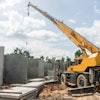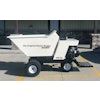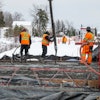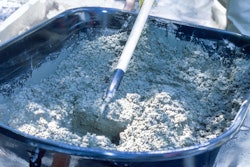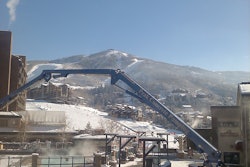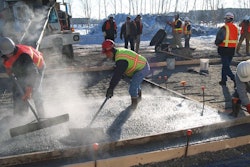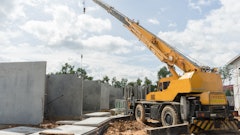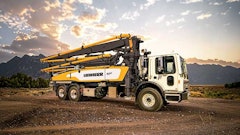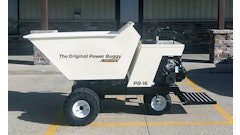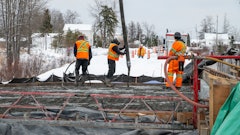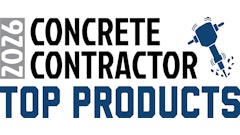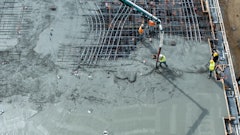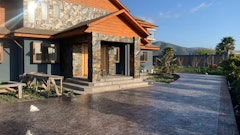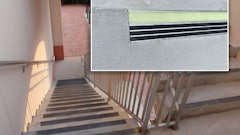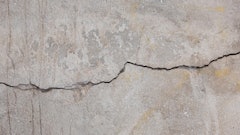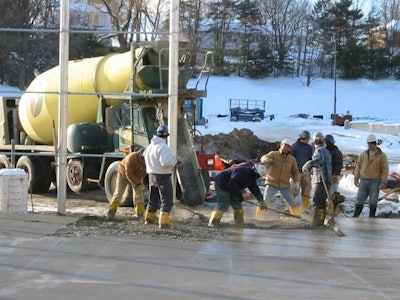
As construction timelines stretch deeper into the colder months, concrete contractors are increasingly expected to deliver high-performance placements under challenging conditions. Cold weather can slow hydration, delay strength gain and significantly increase the risk of early-age concrete damage. Without proactive measures and technical know-how, cold-weather concreting can lead to compromised structural performance, costly repairs or outright failure.
Fortunately, through adherence to industry standards such as ACI 306R-16: Guide to Cold Weather Concreting and strategic use of material technologies governed by ASTM C494: Standard Specification for Chemical Admixtures for Concrete, contractors can successfully navigate the cold-weather construction window. This article explores the mechanisms of cold-weather damage, outlines the latest guidance for winter placements, and discusses how informed planning and proper material selection can turn a seasonal challenge into an opportunity for superior performance.
The Challenges of Cold Weather
ACI 306R-16 defines cold weather as a period when, for more than three consecutive days, the average daily temperature is below 40° F (4° C), and the air temperature does not exceed 50° F (10° C) for more than half of any 24-hour period. These parameters are not uncommon in many construction zones from late autumn through early spring. When these conditions prevail, the risk of fresh concrete freezing before achieving sufficient strength becomes a primary concern. Freezing at early ages, particularly before the concrete reaches about 500 psi (3.4 MPa), can severely disrupt the cement hydration process, leading to internal microcracking and a permanent reduction in structural integrity.
Compounding this issue is the slower rate of strength development in colder environments. Without sufficient internal heat or external protection, concrete is vulnerable for longer periods. Contractors must also account for temperature gradients within the structure, which can lead to differential movement, internal stresses and surface cracking. Thus, cold-weather concreting requires not just site preparedness but a fundamentally different approach to mix design, placement and curing.
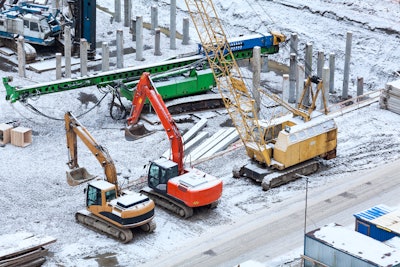 Successful winter concrete work starts with planning for cold temperatures and proper protection.The Euclid Chemical Company
Successful winter concrete work starts with planning for cold temperatures and proper protection.The Euclid Chemical Company
Aligning Performance with ACI’s Four Pillars
Cold-weather concreting hinges on a framework of technical principles rooted in ACI 306R-16. Often referred to as the “four pillars,” they form the foundation of effective winter installation strategies.
1. Prevent Freezing of Early-Age Concrete
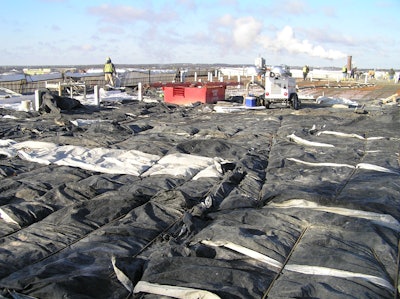 Curing blankets protect freshly placed concrete from freezing temperatures—an essential step in cold weather concreting to ensure proper strength development and surface durability.The Euclid Chemical Company
Curing blankets protect freshly placed concrete from freezing temperatures—an essential step in cold weather concreting to ensure proper strength development and surface durability.The Euclid Chemical Company
Freezing before adequate strength is achieved can cause ice crystal formation within the cement paste matrix, resulting in irreversible structural damage. This is particularly critical in flatwork or thin sections where temperature loss occurs rapidly.
Protective measures may include the use of insulated blankets, temporary enclosures or heated formwork systems — often in combination — to shield early-age concrete from exposure.
2. Promote Adequate Strength Development
Since hydration slows significantly at low temperatures, maintaining a curing environment that encourages strength gain is crucial. ACI recommends that concrete be maintained at or above 50° F (10° C) for at least the first 48 hours after placement. This period is critical for achieving structural milestones and maintaining construction schedules.
Methods to promote early strength include using high early-strength cement (Type III), preheating mix water and aggregates, and incorporating accelerating admixtures approved under ASTM C494. These techniques allow for earlier form removal and load application.
3. Minimize Thermal Shock & Cracking
When temperature gradients form between the surface and interior of a concrete section — or between different structural components — thermal stress can result in cracking. Rapid heating or cooling can exacerbate this issue. Contractors should control the rate of temperature change, particularly during the transition from heated enclosures to ambient conditions.
ACI 306R-16 recommends a gradual reduction in temperature, ideally not more than 20° F (11° C) per day, to prevent thermal shock. This guideline also applies to concrete stored in precast yards or transported to cold sites, where thermal equilibrium must be carefully managed.
4. Maintain Uniform Concrete Temperature
Temperature consistency across the volume of concrete is key to avoiding internal differential shrinkage and uneven curing. In cold weather, the perimeter of a slab or exposed areas of a column can cool much faster than the interior, setting up stress fields that lead to cracking. To mitigate this, ACI recommends thorough planning of placement sequencing, form insulation, and internal temperature monitoring using thermocouples or maturity meters. This ensures that concrete cures evenly and develops its intended mechanical properties throughout.
These four pillars should be treated as interconnected components of a larger winter concreting strategy. Each decision — whether it involves curing method, admixture use or mix temperature — should be evaluated based on its ability to produce consistently successful outcomes.
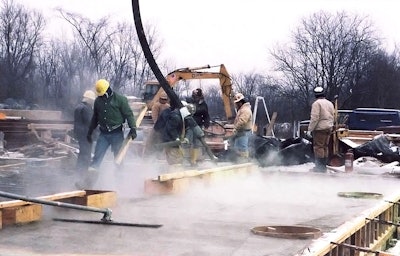 Winter placement in progress—contractors use admixture-enhanced mixes to keep concrete on track despite freezing temps.The Euclid Chemical Company
Winter placement in progress—contractors use admixture-enhanced mixes to keep concrete on track despite freezing temps.The Euclid Chemical Company
Mix Design Considerations for Cold Weather
Concrete mix design is a contractor’s most critical tool for cold weather performance. Adjustments to traditional warm-weather mixes are necessary to accelerate hydration, preserve workability, and promote early-age strength development.
Increasing the cementitious content of the mix, particularly with a high early-strength cement such as ASTM C150 Type III, boosts internal heat generation and reduces set time. It is generally advisable to avoid supplementary cementitious materials like fly ash and slag during winter placements, as they tend to extend set times and delay strength gain. In certain cases, low dosages may be retained if offset by performance admixtures or heat control measures.
Another important consideration is the temperature of mixing water and aggregates. Preheating these components is a well-established method to raise the initial concrete temperature, thereby giving the mix a thermal head start. However, the practice must be executed with caution. ACI 306R-16 warns against using water above 180° F (82° C), as excessive heat can cause flash setting or damage aggregate structure. Aggregates should be stored under cover to avoid ice contamination and thermal shock during batching. Mixes should be designed to achieve a slump and workability that minimize retempering, which can increase water content and compromise cold weather durability.
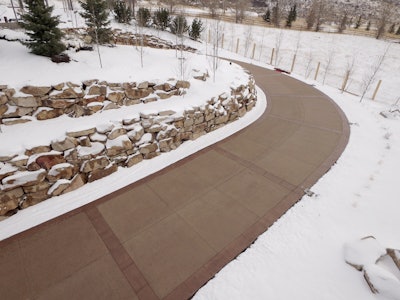 A colored concrete walkway stands up to harsh winter conditions thanks to proper cold weather concreting practices—proof that durability and aesthetics can go hand in hand, even in freezing temperatures.The Euclid Chemical Company
A colored concrete walkway stands up to harsh winter conditions thanks to proper cold weather concreting practices—proof that durability and aesthetics can go hand in hand, even in freezing temperatures.The Euclid Chemical Company
A Technical Toolbox for Concrete Admixtures
Chemical admixtures play an indispensable role in cold weather concreting and are governed under ASTM C494 for performance and compatibility standards. Accelerating admixtures are among the most critical in this context. These additives, available in both chloride-based and non-chloride formulations, expedite the rate of hydration and allow concrete to reach its set and early strength thresholds more rapidly. Non-chloride accelerators are strongly recommended for steel-reinforced or architectural concrete to avoid corrosion or surface discoloration. The precise dosage and compatibility with other mix components should be confirmed through laboratory testing, particularly for mixes that include supplementary cementitious materials or high-range water reducers.
Water-reducing admixtures, including mid-range and high-range formulations, improve concrete workability without increasing water content. This is essential in cold climates, where reduced evaporation can lead to water-rich surfaces prone to freeze-thaw deterioration. By maintaining a low water-cement ratio while still achieving adequate flow, these admixtures support durable placements and effective compaction. Air-entraining agents are another critical tool, especially for exterior concrete exposed to freeze-thaw cycles. These admixtures generate microscopic air bubbles that serve as relief chambers for expanding water, greatly enhancing durability under repeated freezing and thawing. When properly proportioned and tested, admixtures can provide performance benefits that extend beyond cold weather and into the service life of the structure.
Execution: From Site Prep to Field Success
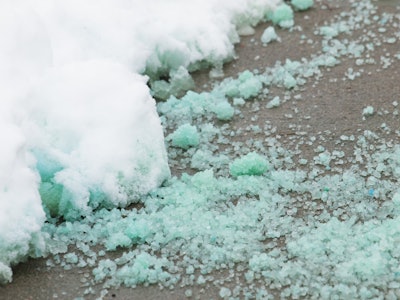 Deicing salts can accelerate surface damage on unprotected concrete during winter—highlighting the importance of proper mix design, curing, and the use of protective sealers in cold weather concreting.The Euclid Chemical Company
Deicing salts can accelerate surface damage on unprotected concrete during winter—highlighting the importance of proper mix design, curing, and the use of protective sealers in cold weather concreting.The Euclid Chemical Company
Equally important is the post-placement phase. Monitoring internal concrete temperature using data loggers or maturity methods ensures that the curing environment remains within ACI-recommended thresholds. When the curing period is complete, temperature reduction must be gradual to avoid inducing thermal stress. Likewise, formwork should remain in place until field-cured cylinders or maturity data confirm the concrete has reached appropriate strength levels. Though timelines may be extended in many cases, the payoff is long-term durability and performance.
A recent Midwest tilt-up project illustrates this approach in action. Facing ambient temperatures below 20° F (-6.7° C), the contractor preheated mix water to 140° F (60° C), kept aggregates dry and covered, and used a non-chloride accelerator and mid-range water reducer per ASTM C494. Temporary enclosures and insulated blankets maintained curing temperatures for 72 hours, and strength testing confirmed safe formwork removal. The result: no cracking, no freeze damage and an on-time, high-performance concrete installation.

